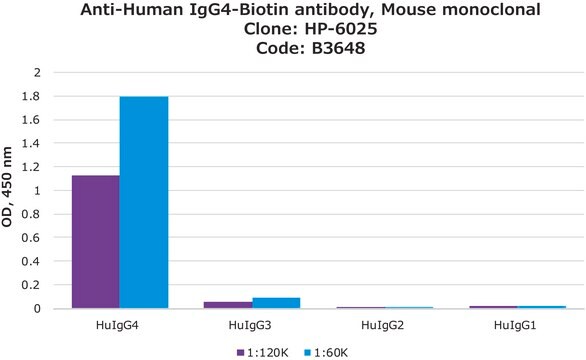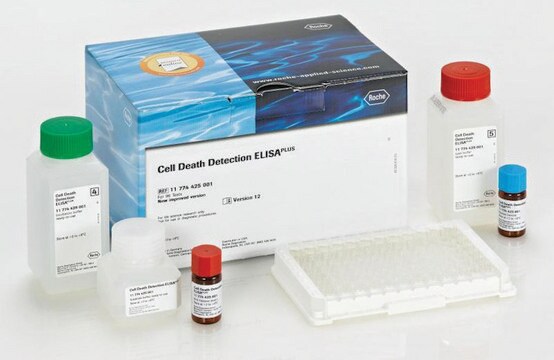일반 설명
We are committed to bringing you greener alternative products, which adhere to one or more of The 12 Principles of Green Chemistry. This antibody is Preservative-free, produced without the harm or sacrifice of animals and exceptionally stable to allow for ambient shipping and storage if needed and thus aligns with "Waste Prevention", "Designing Safer Chemicals" and "Design for Energy Efficiency".
Click here for more information.
ZooMAb® antibodies represent an entirely new generation of recombinant monoclonal antibodies. Each ZooMAb® antibody is manufactured using our proprietary recombinant expression system, purified to homogeneity, and precisely dispensed to produce robust and highly reproducible lot-to-lot consistency. Only top-performing clones are released for use by researchers. Each antibody is validated for high specificity and affinity across multiple applications, including its most commonly used application. ZooMAb® antibodies are reliably available and ready to ship when you need them.
특이성
Clone 2B15 is a ZooMAb® rabbit recombinant monoclonal antibody that specifically detects Fanconi-associated nuclease 1 (FAN1). It targets an epitope within 25 amino acids from the N-terminal half.
면역원
KLH-conjugated linear peptide corresponding to 25 amino acids from the N-terminal half of human Fanconi-associated nuclease 1 (FAN1).
애플리케이션
Quality Control Testing
Evaluated by Immunohistochemistry (Paraffin) in Human spleen tissue sections.
Immunohistochemistry (Paraffin) Analysis: A 1:1,000 dilution of this antibody detected FAN1 in Human spleen tissue sections.
Tested Applications
Immunofluorescence Analysis: A 1:1,000 dilution from a representative lot detected FAN1 in Human spleen tissue sections.
Affinity Binding Assay: A representative lot of this antibody bound FAN1 peptide with a KD of 9.5 x 10-8 in an affinity binding assay.
Immunocytochemistry Analysis: A 1:100 dilution from a representative lot detected FAN1 in A431 cells.
Note: Actual optimal working dilutions must be determined by end user as specimens, and experimental conditions may vary with the end user.
표적 설명
Fanconi-associated nuclease 1 (UniProt: Q9Y2M0; also known as EC:3.1.21, FANCD2/FANCI-associated nuclease 1, hFAN1, Myotubularin-related protein 15) is encoded by the FAN1 (also known as KIAA1018, MTMR15) gene (Gene ID: 22909) in human. FAN1 is a nuclease that is required for the repair of DNA interstrand cross-links (ICL). It is recruited to the sites of DNA damage by monoubiquitinated FANCD2, an effector of ATR signaling. It acts as a 5′-3′ exonuclease that anchors at a cut end of DNA and cleaves DNA successively at every third nucleotide, allowing to excise an ICL from one strand through flanking incisions. It is specifically involved in repair of ICL-induced DNA breaks and is required for efficient homologous recombination. However, it is not involved in DNA double-strand breaks resection. It is shown to hydrolytically remove 5′-nucleotides successively from the 3′-hydroxy termini of 3′-hydroxy-terminated oligonucleotides. FAN1 is reported to interact with MLH1 via two adjacent MLH1-binding sites, referred to as MLH1-interacting protein (MIP) box and MLH1-interacting motif (MIM). This interaction is regulated during the cell cycle and is inhibited in G2/M phase following CDK1/2-mediated phosphorylation of serine 126 within the MIP box of FAN1. Disruption of the FAN1-MLH1 interaction is reported to cause hypersensitivity to DNA cross-linking agents and defective repair of slipped-CAG/CTG repeats. Two isoforms of FAN1 have been described that are produced by alternative splicing. This ZooMAb® recombinant monoclonal antibody, generated by our propriety technology, offers significantly enhanced specificity, affinity, reproducibility, and stability over conventional monoclonals. (Ref.: Porro, A., et al. (2021). , Sci. Adv. 7; eabf7906; Thongthip, S., et al. (2016). Genes & Dev. 2016. 30: 645-659; Wang, R., et al. (2014). Science. 346(6213); 1127-1130; Mackay, C., et al. (2010). Cell. 142(1); 65-76).
물리적 형태
Purified recombinant rabbit monoclonal antibody IgG, lyophilized in PBS with 5% Trehalose, normal appearance a coarse or translucent resin. The PBS/trehalose components in the ZooMAb formulation can have the appearance of a semi-solid (bead like gel) after lyophilization. This is a normal phenomenon. Please follow the recommended reconstitution procedure in the data sheet to dissolve the semi-solid, bead-like, gel-appearing material. The resulting antibody solution is completely stable and functional as proven by full functional testing. Contains no biocide or preservatives, such as azide, or any animal by-products. Larger pack sizes provided as multiples of 25 µL.
저장 및 안정성
Recommend storage of lyophilized product at 2-8°C; Before reconstitution, micro-centrifuge vials briefly to spin down material to bottom of the vial; Reconstitute each vial by adding 25 µL of filtered lab grade water or PBS; Reconstituted antibodies can be stored at 2-8°C, or -20°C for long term storage. Avoid repeated freeze-thaws.
법적 정보
ZooMAb is a registered trademark of Merck KGaA, Darmstadt, Germany
면책조항
Unless otherwise stated in our catalog or other company documentation accompanying the product(s), our products are intended for research use only and are not to be used for any other purpose, which includes but is not limited to, unauthorized commercial uses, in vitro diagnostic uses, ex vivo or in vivo therapeutic uses or any type of consumption or application to humans or animals.







